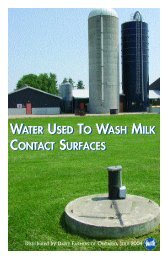Canadian Quality Milk On-Farm Food Safety Program - Centre ...
Canadian Quality Milk On-Farm Food Safety Program - Centre ...
Canadian Quality Milk On-Farm Food Safety Program - Centre ...
You also want an ePaper? Increase the reach of your titles
YUMPU automatically turns print PDFs into web optimized ePapers that Google loves.
<strong>Canadian</strong> <strong>Quality</strong> <strong>Milk</strong><br />
Introduction<br />
All <strong>Canadian</strong> dairy farmers are beef as well as milk producers, and, as such, must<br />
produce safe and wholesome beef. Shipping animals is another Critical Control Point in<br />
the <strong>Canadian</strong> <strong>Quality</strong> <strong>Milk</strong> program. This Critical Control Point has two hazards<br />
associated with it: chemical - livestock medicines and chemical residues (including any<br />
residues that may persist following vaccinations), and physical - broken needles. All<br />
animals leaving a dairy farm have the potential to be slaughtered for beef soon after<br />
sale.<br />
8.1 SHIPPING ANIMALS<br />
Animals are constantly being shipped from a dairy farm for a variety of reasons. Some<br />
cattle are culls due to reproductive problems, mastitis, lameness or other illnesses.<br />
Other cattle are sold as replacement stock for other herds. Bull calves are born on all<br />
dairy farms and are often sold to the veal industry or other buyers to end up as beef.<br />
Whenever cattle are shipped, you have a responsibility to ensure that the animals are<br />
safe to enter the human food chain. Appropriate withdrawal times for livestock<br />
medicines and chemicals must be observed for any animals being sold or shipped<br />
directly to slaughter. As a result, when an animal is being shipped you must check to<br />
ensure that there are no chemical residues or broken needles in the animal. If the<br />
animal is carrying residues or a broken needle, then you must transfer that information<br />
to the next buyer or the transporter. See the Workbook for a sample shipping record.<br />
<strong>On</strong>ce cattle leave the dairy farm, they must be identified according to the National<br />
Livestock Identification for Dairy (NLID) standards or according to Agri-Tracabilité<br />
Québec (ATQ). You must ensure that all cattle intended for shipping are identified with<br />
NLID tags or Agri-Tracabilité Québec tags.<br />
Shipping animals is a Critical Control Point on a dairy farm because it is the last<br />
step in the process where you can control whether or not an animal carrying a<br />
chemical residue or broken needle is shipped, or whether the appropriate<br />
information is transferred to the next buyer or transporter.<br />
Critical Control Point: Shipping animals<br />
Hazards: Chemical: livestock medicines, chemicals and biological products (e.g.<br />
vaccines)<br />
Physical: broken needles<br />
8—2<br />
June 2010
















